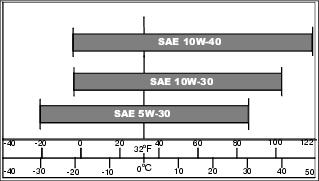You didn't say what engine manufacturer you have in your equipment, but Briggs and Stratton's number one oil recommendation FOR ALL THERE SMALL ENGINES is 5W30 synthetic.
Let me repeat that for you, Briggs and Stratton's NUMBER ONE oil recommendation FOR ALL THERE SMALL ENGINES is 5W30 synthetic, and has been for at least 5 years now.
The chart posted above only applies if you are using conventional, non-synthetic oil.
They also recommend 10W30 conventional and SAE30 conventional oil in their engines, but say that 5W30 synthetic oil offers the best protection.
Mobil 1 5W30 is a fantastic oil for your application and will serve you well.
----------------------------------------------------------------------------
Here is the current viscosity chart provided by Briggs and Stratton:
Oil Recommendation
SAE 30 40° F and higher (5° C and higher) is good for all purpose use above 40° F, use below 40° F will cause hard starting.
10W-30 0 to 100° F (-18 to 38° C) is better for varying temperature conditions. This grade of oil improves cold weather starting, but may increase oil consumption at 80° F(27° C) or higher.
Synthetic 5W-30 -20 to 120° F (-30 to 40° C) provides the best protection at all temperatures as well as improved starting with less oil consumption.
5W-30 40° F and below (5° C and below) is recommended for winter use, and works best in cold conditions.




